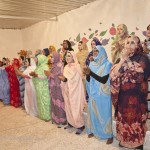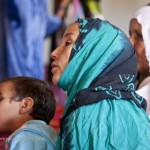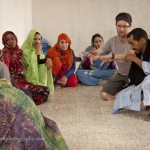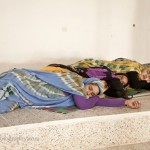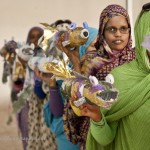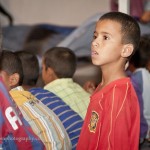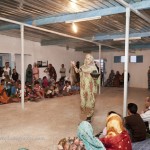David Stothard is an Associate Researcher of the TYA Centre and Creative Director of Theatre for Olive Branch Arts.
What follows is a paper written by David, offering an account of Within the Waves, a new piece of work for young audiences developed on the refugee camps of the Western Sahara, by his company. The project was part of David’s research output whilst he studied on Rose Bruford College’s MA in Theatre for Young Audiences and was supported and documented for the TYA Centre.
The paper explores how theatre makers respond to the potential tensions between applied theatre and art theatre practice directed at young people.
Applied Theatre or Art Theatre: how work within a Sahrawi Refugee camp helps to define Theatre for Young Audiences practice
I remain an artist who is driven by a need to make work of quality, that not only speaks to an audience through an internal, personal dialogue, but also on a broader social and political scale, I find myself becoming increasingly frustrated as I try to identify ways of working which gives equal, if not more emphasis to aesthetic considerations. This tension has certainly informed my work with the Sahrawi refugee community, which I outline in this paper, in an effort to identify a possible bridge between these internal conflicts.
Working with approximately twenty young people between the ages of 16 – 24, the aim of this yearly two-week residency is to deliver a theatre-training program that offers participants the opportunity to devise and perform an original piece of theatre, with the longer-term objectives of empowering them to tell their stories, celebrate their culture and facilitate the establishment of a permanent youth theatre in their community. Historically, previous visits have followed familiar discourses of refugee theatre with the creation of culturally specific plays that offer space to ‘hold on to cultures of origin inside an alien environment’ (Thompson, Hughes, Balfour, 2009, p.84), or ‘legitimize the individual’s status as a ‘refugee’ in a hostile social environment’ (Thompson, Hughes, Balfour, 2009, p.85). Specific requests asked of me in relation to my most recent visit to the camps have led me to question my own motivations in creatively engaging with this community, asking who is this theatre for and, most importantly, what is it trying to achieve? By exploring where overlaps between TYA practices and what might be termed ‘applied’ theatre approaches may occur, I wanted to assess how successful my attempts were in trying to create a theatre piece that was able to engage not only the hearts, but the minds of its participants and audience members alike.
The Sahrawi Project 2012
There were many practical and ethical considerations to take into account when deciding upon the content for this project. Prior to our arrival, discussions with Mohammed Gali, the Director of Sahrawi Theatre highlighted a sense that this community knew their own culture, but have a desire to push their young people ‘beyond what they already know’. A request was made that we bring Western material to the residency, using a text and/or wider themes as a framework for the participants to build upon and place in a relevant cultural context. Through the exploration of ‘foreign’ stories, their ambition was to create a universal piece of theatre that spoke of human heritage, rather than making any culturally specific statement. While this idea offered certain practical benefits regarding the duration of the project - namely that we could enter into a devising process straight away rather than taking up time finding a story that we wanted to tell - it also posed difficult questions regarding the ethical responsibilities of working within a sensitive political environment, the perceived needs of the community we were going to be working with and what exactly the project was trying to achieve. An early interview with John Martin, a practitioner specializing in Theatre for Development, Refugee Theatre and Arts for Social Change, highlighted these dilemmas. Warning against the creation of a performance piece, he proposed a Theatre for Development model that focused on a more intensive period of training. As Artistic Director of PAN Intercultural Arts, John was a founding director of the Vidya Theatre Company. This project, co-run with the Darpana Academy of Performing Arts in India, had previously identified an issue regarding the low status of girls within the slums of Ahmedabad, which was intensified by poverty and social prejudice within the wider community. The project sort to challenge this mindset, and over a period of three years a team of researchers from the slums were engaged to explore these issues. A peer-group was formed from people living in the affected communities, who were led through an intensive three-month drama training program, after which they were able to begin creating performances, aimed at provoking discussion and debate within the communities. The Vidya project is now operating independently ten years after its inception. This model seems to highlight a number of flaws in any long-term ambitions for my work on the camps; it would seem naïve to expect a yearly two-week residency to empower participants enough to enable them to make work independently. In addition, there were further considerations to take into account.
Creatively engaging with a community with such turmoil in its history brings great responsibility, and there may be any number of social and political issues within Sahrawi society that would benefit from focused Theatre for Development intervention and the possibilities for long-term social change that it offers. Understandably, a people who are existing on the fringes of society, and whose repression is perpetuated through the forceful denial of its history, culture and identity, will be suspicious of intervention from any outside agency. The reluctance of this community to divulge any information that may compromise them on a world stage was apparent from our earlier visits, and it is only now, after four visits, that we are beginning to be given access to the true inner workings of the camps as a whole. Without the benefit of an extensive research period, such as that undertaken as part of the Vidya project, it could be concluded that we would be required to arrive on the camps with a pre-conceived agenda, and that uncomfortable assumptions may need to be made regarding which sections of society needed to be ‘transformed’; by trying to address problems that were not being openly communicated, would I be seen to be undermining the community’s sense of self, or adding to the feelings of attack so profoundly felt in an already fractured society?
One particularly pressing issue on the camps is the current political stalemate between the Polisario Front and the occupying power Morocco. Having remained in exile for thirty-seven years, with no significant progression since the 1991 UN brokered ceasefire, there is currently a growing sense of frustration and unrest within the youth on the camps. They believe that the Sahrawi community must once again take up arms as a means of liberation, whilst elders insist on a continuation of the current political strategy of peaceful protest. This particular issue could provide rich territory for exploration through Boal’s ‘Poetics of the Oppressed’ (Boal, 2005, p.108), the aims of which are to liberate and activate spectators through active discussion and debate. In his critique of short-term participatory arts practice in the UK, Tony Jackson warns of the frustrations of; ‘activating children towards decisions and understandings about the need for change in society only then to walk away, leaving them in the hands of the institution, resulting in little or no change’ (ed. Jackson, 1993, p.27), and illustrates a frustration I have keenly felt when working with groups of young people in a social capacity here in the UK. Operating in a potential war zone, however, could result in far more extreme outcomes. James Thompson highlights these risks when he warns us that ‘the majority of practices in war zones cannot be untangled from war-making practices; even work that announces itself as avowedly anti-war can be proposing a fight as an alternative’ (Thompson, Hughes, Balfour, 2009, p. 8). I was forced to acknowledge the limits of my personal practice in this regard, alongside an unwillingness for my lack of experience to: at best, foster feelings of animosity within the Sahrawi community; at worst risk activating young people towards the taking up of arms and a return to war.
Looking at John Martin’s definition of Theatre for Development as ‘the practice of using theatre to address issues and find solutions to problems arising from the specific experience of living in a developing situation, and to improve the lives of people living in so-called developing countries’ (Mehta, Adebayo, Martin, 2010, p.20), I concluded that my work with the Western Saharan community could not, in these terms, be suitably defined by this methodology. Although the appropriateness of utilizing Western material to create theatre in this context had been questioned, the fact remained that this was what the community were asking for. If adopting external material as a creative stimulus opened the project up to accusations of cultural appropriation, it could also be argued that pursuing other modes of content or practice may have entertained the same criticisms. Was it possible instead to find stories of that would ignite the imaginations of the young participants, whilst at the same time illuminate their lived experiences? How could I ensure that any ‘fight’ remained a metaphorical one, without the end result seeming at once hollow or inappropriate in an environment where cultural identity is being forcibly repressed?
Many options were considered whilst deciding on material that was best suited to the project. Inspiration was initially provided by the children’s novel ‘Kensuke’s Kingdom’ (Mopurgo, 2000), which tells the story of Michael, a ten-year-old boy who, after embarking on a round-the-world trip with his family, finds himself separated from them and washed up on an island in the Pacific. Struggling to survive on his own, he encounters an elderly Japanese man who has been living on the island for many years. The two become friends, offering each other the practical and emotional support needed to survive, eventually devising a successful plan to leave. At the last moment however, the old man has a change of heart, telling Michael that he will not be sailing home with him. Believing that all of his family perished in Nagasaki during the Second World War, he explains that this island is his Kingdom now, he is the Emperor and an Emperor must stay with his Kingdom. Michael leaves Kensuke behind, and is finally reunited with his parents.
This story explores many pertinent ideas; the notions of being ‘shipwrecked’ or ‘adrift’, alongside any complimentary themes of loss, isolation and resilience would hopefully carry great resonance for the participants of the project and the Sahrawi community as a whole. Further works were subsequently examined that explored similar territory, including ‘Robinson Crusoe’ and ‘The Tempest’, each offering additional perspectives on the notions of survival, religion, power, betrayal, and forgiveness. From a theatrical perspective I was hugely excited by the creative challenge of bringing the ocean to the desert, alongside the prospect of how the material would be interpreted by a group of young people, some of whom may never have seen the sea before.
I chose to create a dramaturgical architecture, alongside a range of source material for the participants to explore. This approach offered several practical and creative benefits that would fundamentally inform the way that I would be able to work. It presented the community with an opportunity to create a new and original piece of theatre, using external source material, which would have the capacity to be appropriate for an audience of varying ages. The creative stimuli would be flexible enough to incorporate a group of young participants whose number, age, gender and experience would not be known until our arrival on the camps, whilst allowing them to generate their own interpretations rather than working to a pre-selected script. Various elements within the thematic stimulus offered a scope for physical storytelling, enabling us to transcend any language barrier between the participants and myself, whilst also encouraging the inclusion of those less confident or experienced. Finally, by using elements of text and wider themes as a framework for the participants to build on and place in a Sahrawi context, the hope was that participants would feel empowered enough to take a level of creative control of the story they wanted to tell, fostering a sense of ownership within the young artists.
The Process
‘from limitation to stimulation’
(Noel Greig cited in Thompson, 2005, p.173)
This phrase reminds us how creativity may in fact be enhanced by limitation. In this instance, initial exercises in the rehearsal process - as much aimed at establishing an atmosphere of creative play as generating material for the theatre piece – had provided rich territory for exploration. As a natural progression from the earlier creation of physical images related to the environment we were looking to explore, (a boat, palm tree, shoal of fish, storm etc.), I began introducing various quotes for the group to physically respond to (see Appendix A p.28). One particular quote from the film ‘Castaway’ (2000); ‘I have to keep breathing, because tomorrow the sun will rise and who knows what the tide will bring’, provoked very different responses from two separate groups. Whilst one group created an incredibly powerful image of oppression; of prisoners in a filthy, overcrowded prison cell whilst family members plead with unsympathetic officials for their release, the second showed a very idyllic, domesticated setting; that of a family going about their daily life, making tea, cooking, nursing the children, dancing and singing. Unconsciously, but perhaps unsurprisingly, both groups had started, albeit independently, to work within Boal’s methodology of Image Theatre . These two images, although not a direct example of this practice in that they were created by two separate groups rather than an individual, highlight how this devising exercise may have been further utilized in an Applied Theatre setting. If we look at the images in terms of Boal’s methodology, then the first would clearly represent the actual image that this particular group had of their community, with the second representing an ideal image. In order to complete the revolution of this exercise, there is a need to construct a transitional image (Boal, 2005, p.112), that is an image to illustrate how the community might move from one reality to the next, or how this desired change might be realized. Although these responses were not, on this occasion, directly linked to a specific social or political provocation, the fact remains that they were genuine responses from young people whose day-to-day life is affected by the aggressive repression of their culture, identity and community as a whole. Upon reflection, these organic representations had so fluidly evolved into a Theatre of the Oppressed model, that I felt a moral responsibility within my practice to explore them further, thereby facilitating a platform for discussion and debate. Perhaps the angle from which I had approached this devising process would prove to be too obtuse and subsequently unable to take the young people away from their fixed, lived realities and into a fictional narrative.
It is here that I must examine my own personal motivations for moving away from the material that I had been offered. Having previously identified the risks involved in confronting potentially inflammatory material, and my own reticence to do so in this context, Chris Vine offers alternative considerations. He warns that by creating; ‘their own theatre about their own oppressions to play back to their own groups’, there is a danger that groups; ‘can thus become locked into a circle of self-perpetuating perceptions and under these circumstances the work easily becomes diverted into an exercise in self-expression and mutual commiseration’ (ed. Jackson, 1993, p.127). While I could reference many discourses to rationalize my choice of practice, in this instance I feel compelled to admit that my main motivation for doing so had much more to do with my own personal artistic ambitions for the project. That these initial images were not examined further, nor indeed found their way into the final piece, had more to do with my perceived absence of aesthetics, fiction and imagination in the. This was a clear example of my own personal agenda as a theatre-maker taking precedence over the young people’s responses, and marked the crossing of a boundary between an intended environment of ‘guidance and support’ and an actual one of ‘control and manipulation’ (Greig, 2008, p.181). By acknowledging a clear shift away from content that had the potential to be highly effective in the realms of Applied Theatre practice, I was forced to revisit earlier questions regarding the appropriation of Western material, its ability to connect with the Sahrawi community on a personal, yet imaginative level, alongside any personal ambitions I may be harboring.
Perhaps then, my true aspirations for this project were simply that: my own artistic and aesthetic aspirations. If we are to assert that; ‘artists create from their own experiences, following their own hearts rather than working to any dicta of a didactical educational approach (Schonmann, 2006, p.19), then perhaps we need to look inward, rather than outward, in the search for true ‘art’. I make reference here to Mark Storor, a visual and performance artist who, often working within participatory practices with amateur performers, states that; ‘art must come from us, from the heart and soul. If it doesn’t come from here then what’s the point? If it’s within us, then it’s within others and will speak to them’ (Mark Storor, Personal Interview, 2012). Having attended a week-long residency with Mark shortly before my visit to the camps, I experienced first hand the resonance of self that can be generated through his particular approach and how, when given necessary time and space, a deep and profound common theatrical language can emerge within a group. Exercises such as the drawing of one’s physical self whilst blindfolded provided a safe way of removing the fear of artistic inadequacy, whilst encouraging an inward perspective of the artist involved. Asking participants to identify themselves with objects, animals, elements, and the subsequent creative writing activities that followed, allowed easy access to a world of personal metaphor. Finally, the resulting body-outline self-portraits provided a fertile environment in which members of the group were able to explore further notions of self-perception. Highly effective in a range of sensitive environments, ‘For the Best’ – a theatre piece made in co-production with the Unicorn Theatre and in collaboration with nine children living in the renal unit of a hospital school – provides an excellent example of how his approach is able to achieve project aims that include;
- ‘To evolve a unique and robust theatrical language for the presentation of sensitive issues to public audiences through collaboration with non-professional participants’
- ‘For participants to gain new insights into their own and others experiences; and to enhance skills, self-esteem and confidence through a creative and expressive arts process’
- ‘For the wider public to engage with a unique, original and innovative theatrical experience’ (Steele, 2009).
I felt that these exercises, alongside their associated aims, would be hugely transferable in a refugee context. However, if we are to agree with Tony Graham when he states that; ‘Good work takes time to gestate’ (Graham, 2002, p.42), then previous criticisms regarding the time constraints involved in this project must, once again, be acknowledged. Having asserted doubts in an ability to explore more sensitive social issues within this timeframe, then surely there would also be an inability to create the complex and aesthetically demanding theatre that was my desire.
Time constraints were compounded by internal politics within the Ministry of Culture on the camps, meaning that we weren’t actually able to begin work until five days into our visit. With only six and a half days in which to make a performance, I still felt anxious that the world of the play must come from the participants if it was indeed to hold any resonance for their community. Discussions with my translator for the project had unsurprisingly revealed that; ‘the sea is strange’ for this community (Zorgan Laroussi, Personal Interview, 2012). Born into a refugee camp in the middle of the Sahara, these were young adults with little or no concept of the ocean or any of its associations. I presented the group with a series of images for them to respond to (see Appendix 1 p.31-32). Two were selected for their literal representations of the subject matter, whilst others were open to wider interpretation. The hope was that elements of the subject matter would find their way into the stories, whilst giving participants space for their own imaginative engagement. Splitting the group into four, stories were generated from each of the separate images (see Appendix 2 p.33-36). Taking the stories away, elements from each were merged to create an action synopsis from which we were then able to explore the playable actions of the narrative (see Appendix 2 p.37-38).
Through my involvement with NiE’s ‘Tales from the River Thames’ earlier that year, I recognize that this stage of the project offered me the possibility to work with an established theatre making methodology. Based upon stories written by year 5 and 6 pupils from across London, ‘Tales from the River Thames’ was a project that was clearly framed within both an artistic and educational context. Incorporating storytelling workshops that were designed to fulfill the Unicorn Theatre’s Education Department aims to ‘look more closely at the connection between the stage and the classroom and to investigate the impact on the children’s development and learning’ (Thompson/Unicorn Theatre, 2011, p.3), alongside the ambitions of a director who, unconcerned with educational outcomes, simply wanted to; ‘get great stories’ and; ‘create beautiful theatre’ (Alex Byrne, Personal Interview, 2011). This was an example of a practice that contained the authentic voice of the child at its core, whilst remaining firmly focused upon making work that reflected the artistic ambitions of its makers. Once any school-based activity had been completed, the NiE creative team was liberated from this setting and given complete artistic license over the stories that the pupils had generated.
Working with a team of drama and movement therapists, who accompanied us on this occasion, suggested a practice whereby an applied ‘social’ sensitivity could actually liberate and enrich the creative process, as I felt was evidenced by my experiences with ‘Tales from the River Thames’. Initially present to provide a creative training opportunity for staff working within special needs schools on the camps, the team also looked to widen participation on the project by creatively engaging with patients from the Landmine Victim Centre. With some patients permanently bedridden and living in isolation from the rest of the community, the team decided to explore some of the themes and source materials that the young people were working on, with patients encouraged to share stories from their youth and offer their own creative responses. This material manifested itself within the project as messages of advice and encouragement for the younger participants, with these ‘messages in a bottle’ sent across the desert to be read and replied to. Some phrases and words of encouragement were also printed on squares of fabric, which were then stitched together, creating a sail to be used in the play. The theatre piece was subsequently performed on a second camp, El Ayoun, for some of the patients and their families. Although this aspect of our residency could be seen as tokenistic due to the small amount of time that was available to it, this intervention found its way into the piece in many profound ways, suggesting a future dual-strand process that could greatly enrich any creative or social objectives of the work.
The Story
The story that was collectively drawn became ‘Within the Heart of the Waves’-an adaptation of a Sahrawi phrase traditionally relating to the geographic position of the community within an ’ocean of sand’. It told the tale of Aisha, a young girl who wanted to travel the world. Despite her family’s disapproval, she sets off on a voyage across the sea, only to find herself shipwrecked on a desert island. Giving herself up for lost, she is surprised to find three boys who are also stranded on the island. An encounter with an old man leads them to the realization that together they have the wisdom, strength and will to leave the island. The old man, however, is not strong enough to make the journey. He asks the young people to take his story with them and is eventually left behind.
Dramaturgically there was a responsibility to make sure that the aesthetic of the play made sense to the audience. One example of this was how we chose to represent the notion of passing time. Initially wanting to incorporate elements from Robinson Crusoe here, the performers creatively played with the notion of using chalk to show the marking of days. It was quickly pointed out however, that this would hold no meaning for our audience. A traditional nomadic practice of laying stones was subsequently adopted, and a group of traditional Sahrawi musicians commissioned to compose a song with which to underscore this moment (see Appendix 2 p.40). Another such consideration was in the reason we had given for our young protagonist to run away from home. The idea of simply leaving to seek adventure would prove too alien a concept in Sahrawi society, and culturally unacceptable. There was a danger that the character would be seen to have abandoned her family, resulting in a lack of empathy from the audience. Looking to the group to provide a solution, many options were presented in the rehearsal room. One such option involved the portrayal of a young girl escaping from an arranged marriage. Although a liberal Muslim society where women enjoy high levels of emancipation, this practice still occurs within some families. Whilst watching this scene, one young woman was brought to tears. Explaining to me that she found the scene to be very sad, her reaction took on greater significance when I learnt that she herself had been married just one month before. I was reminded that focusing on creating product ‘can reduce the number of participants’ and how a less participatory approach can ‘effectively silence young people’ (Thompson, 2005, p.187). I was able to recognize that my focus was not necessarily the ‘pastoral care’ of the group, but rather on the ‘artistic care’ of our piece. My responsibility had shifted from that which I call my ‘first audience’ – the participants of the youth theatre - to that of my ‘second audience’ – the members of the community that would be coming to see our play.
Through the exploration of Western themes and images, the participants were able to create a narrative that, although shaped by an external eye, hopefully still contained the core of their own creative ideas. Gavin Bolton describes participation in drama as having two faces; ‘the ‘game’ of drama where a group of participants share a significant experience, and a theatrical performance where a group of actors present the drama so that an audience might have a significant experience’ (Bolton, 1984, p.103). In the following section I aim to examine the effectiveness of this performance for the participants and audience members alike.
The Performance
As previously acknowledged, this year’s project had become less about explicit agendas of social change, and instead leant more towards a hybrid participatory model of theatre making, as referenced in the NiE example, ‘Tales from the River Thames’. In this sense, my work with this community could easily be perceived simply as a cultural activity to entertain and occupy young people, to provide momentary relief from a barren and hostile environment. I would agree with Matthew Reason when he states that ‘there is nothing fundamentally wrong with sheer entertainment if nothing more is claimed or desired’ (Reason, 2010, p.37), but would argue against any assertion that ‘Within the Heart of the Waves’ was nothing more than a diversion. Whilst remaining cautious of projecting idealized social outcomes onto the project, it is my belief that participants and audience members alike were able to recognize elements of their own personal stories within the fictional narrative. One such example occurred with Maimuna, a participant who was cast in the role of Bashiri. In an early rehearsal she independently changed the number of years that the character had been stranded on the island from sixty, to thirty-seven. Although less effective in terms of the story, this number holds huge significance for the Sahrawi people, representing the number of years that the community have been living in exile. Lines of dialogue that were improvised provided moments of creative synergy; “God has written for me to be on this island” echoed almost exactly lines from Robinson Crusoe illustrating, how certain participants were able to recognize both deeply personal yet widely universal themes of religion and faith through the characters they had created.
Such moments were not exclusive to the young trainees however, with deep resonance felt within the therapeutic interaction at the Landmine Victim Centre. Having explored elements of text from Prospero’s Epilogue in one of the youth theatre sessions (see Appendix 1 p.29), I was amazed to discover that words of advice offered to us by one of the patients were almost an exact replica of two lines of Shakespeare’s text. Spoken by Bashiri as the closing statement of the piece, “All you need is a good wind to fill your sails” (see Appendix 2 p.41), became a rich dramatic metaphor for the belief that the youth need to now take the lead in the struggle for independence.
I had the privilege to observe the piece being enjoyed by old and young alike, with one particular moment where Bashiri proclaims; “With the wisdom, the strength and the will, we can achieve anything”, provoking a spontaneous, yet electrifying moment of vocal solidarity between the performers and their audience. Generational tensions present on the camps also inadvertently found their way into the piece through the manifestation of Michael’s relationship with his elderly friend in ‘Kensuke’s Kingdom’. The idea that for many years no one has known that Kensuke is stranded on his island has a profound resonance with the Sahrawi situation, the community on the camps often referred to in international circles as ‘invisible refugees’ (Zunes, Mundy, 2010, p. 112). Through this relationship we were able to explore what is lost of a culture’s oral history when an elder is lost, hopefully provoking an audience to contemplate how they might bridge a gap between the past and the future.
Finally, we left the piece open-ended, deciding to finish at the point where Aisha and the boys sail away from the island. Gavin Bolton asserts that ‘what the artist offers are indicators open to aesthetic interpretation’ (Bolton, 1984, p.144). Through aesthetic distance, an attempt was made to illuminate the lived experiences of the community in a less representational way, affording an opportunity for them to ‘see’ their situation from a different perspective. By offering such an indicator, we were not only allowing the audience to make their own minds up about the fate of the characters, but able to leave them with a sense of hope whilst not offering any unrealistic expectations of what is possible or real.
Whilst I have argued, in this context, for a theatre weighted towards artistic and aesthetic concerns, rather than one which is created for any instrumental outcome, I do feel that, in conclusion, it would ultimately be reductionist to try to categorize this project purely in terms of an ‘applied’ or ‘non-applied’ theatre practice. I’m not sure that in this instance I agree with Shifra Schonmann when she states that ‘theatre has to stop struggling to define its legitimacy as an educational endeavor; it would do better to concentrate on its own artistic form and its own aesthetic merits’ (Schonmann, 2006, p.10). It is my belief that all art, or should I say all good art, educates, and to negate this aspect of an intervention in this context would be entirely irresponsible.
‘Within the Heart of the Waves’ was an aesthetically rich piece of theatre that drew on the lived experiences of the participants. The piece was not specifically about their position as refugees, but was rather a universal tale about displacement, loss and the hope of recovery. Perhaps any evidence of cross-cultural or cross generational enjoyment was purely a symptom of geographic commonality at the time, but one cannot deny that there existed significant moments of solidarity between the community, alongside moments of great joy and hilarity. Whilst on a personal level I can never completely understand what it is to be a Sahrawi refugee, I, and other members of the audience, were able to connect to these universal themes through a particular and personal shared experience. It is in this way, I believe, that theatre is able to deal with personal or social issues on an intimate level, and it is these claims of ‘universality’ that prevent me from categorizing the performance as Community Theatre.
Although there was no specific social agenda informing the two-week process - preventing me from defining this performance as Theatre in Education - there were clearly educational aspects to the work. Gavin Bolton defines Drama and Learning in the following five ways;
- Learning to do drama
- Learning about drama
- Learning social skills
- Learning language skills
- Learning about one-self (Bolton, 1984, p.148).
Each of these criteria, it could be argued, were present in this practice. Although criticisms will justifiably be leveled at the project’s aspirations for long-term sustainability, I would argue against any viewpoint that limits this project to a simple imparting of theatre skills and training, or leisure activity to provide entertainment. I acknowledge the need to extend the duration of our residencies if we are to have any lasting impact, either practically or artistically, but I must also remind myself that this is a creative relationship that is in its infancy and is, by necessity, an evolving practice that must grow alongside the community with which it engages. To this end, I am excited by the glimpse I have been given of a practice where ‘applied’ theatre elements may work in tandem, or indeed liberate, a creative process.
Outcomes of personal and communal change may be documented and evidenced in a relevant context and with appropriate evaluative procedures in place. In this case however, any conclusions drawn are pure conjecture. I could speculate that the sense of excitement and pride I witnessed in the performers after their first show has instilled a lasting sense of self-esteem and confidence within them. I could argue that, in some way, the play was able to help bridge a divide that currently exists between some of the youth and the elders on the camps. I could argue that the reaction to the piece from the Minister of Culture on the camps – that it would now be filmed and broadcast on Sahrawi television – indicates that it had great cultural resonance for the community.
In truth, I still don’t feel able to define where this practice definitively sits, in the same way that I don’t believe that I can ever fully know what this project meant to the community as a whole. But does it matter? Is it not enough to say that it is an issue of human rights? That those two weeks were about a people’s fundamental right to enjoy the art of theatre in all its manifestations? Why must everything always have a tangible outcome? Is it not enough to simply say that this is a play, and there will be ripples that will hopefully be felt and linger beyond the fleeting moment of performance? After all, is this not the essential power of theatre?
As a final thought I would like to share a story with you that will hopefully serve as an appropriate conclusion to this research journey. After the second performance in El Ayoun, one of the Landmine Victim Centre patients, a partially sighted man named Brahim, who is almost entirely crippled from shrapnel injuries he sustained during the conflict and who had taken great pains to come and see the play, would not let go of my hand and kissed my face eight times. I will never ever know what that moment meant to him, just as Brahim will never know what that moment meant to me. But it was a moment all the same, and one that will stay with me for the rest of my life.



